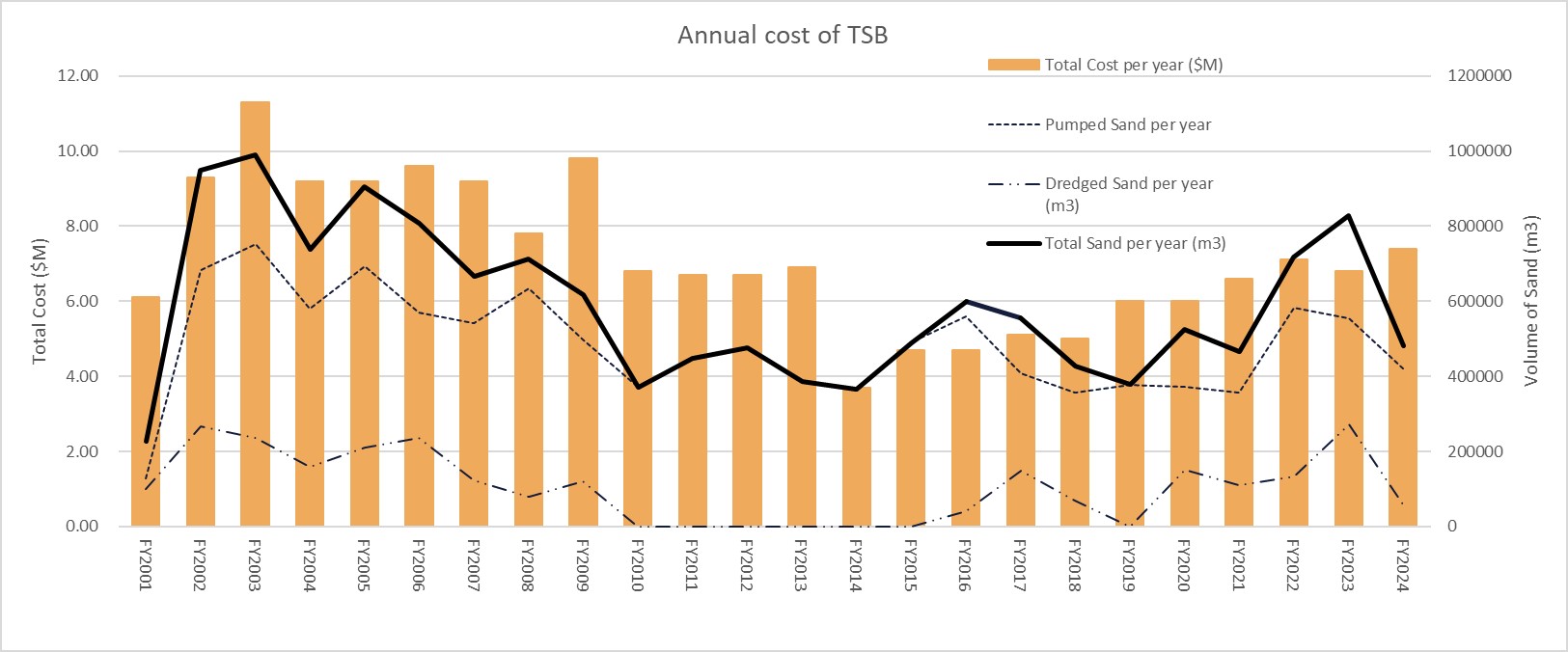General information
Legislation
The New South Wales (NSW) Tweed River Entrance Sand Bypassing Act was passed in 1995 and the Queensland (Qld) Tweed River Entrance Sand Bypassing Project Agreement Act was passed in 1998. The Acts detail the NSW/Qld agreement for the sand bypassing project.
The permanent sand bypassing system
The sand collection system is the key to the successful operation of this project. It has been designed for efficient operation, low operating costs and low maintenance requirements.
The system comprises of a sand collection jetty with an overall length of 450 metres constructed perpendicular to Letitia Spit Beach. A sand trap has been developed under the jetty by the operation of a series of ten submerged jet pumps. The sand trap is maintained as a permanent depression under the sand collection jetty to allow natural processes to feed sand into this trap from the natural littoral drift of sand northwards along the coastline.
The system has been designed to operate with up to four jet pumps working together at the same time. The jet pumps are run on water drawn from the Tweed River. The sand slurry produced is transported through a flume to a slurry pit located on shore. The slurry pit receives the sand slurry and concentrates the sand slurry to the required density.
The sand transfer system draws sand from the slurry pit and pumps it through a 400 mm diameter steel pipeline under the Tweed River to a delivery outlet. Refer to the diagram: Basis of outlet usage for more information on where sand is delivered.
Management operation and sponsors
Tweed Sand Bypassing (TSB) is implemented by NSW Government (The Coordinating State) in conjunction with Queensland Government (The Reviewing State). The City of Gold Coast (CoGC) supports and makes a financial contribution to Tweed Sand Bypassing and the Tweed Shire Council (TSC) also provides management support. TSB is managed and operated by NSW government on behalf of the project sponsors
Scope of works
The general operational activities of Tweed Sand Bypassing (TSB) include:
- Retrieval of sand beneath the jetty and mechanical bypassing/pumping of this sand to any one of the discharge outlets.
- Supplementary dredging from the Tweed River entrance and placement in approved deposition areas. Refer map of available dredge deposition areas.
- Any maintenance or additional construction activities that may be required from time to time to meet the objectives of Tweed Sand Bypassing.
Tweed sand bypassing expenditure
The costs of Tweed Sand Bypassing are shared between the New South Wales and Queensland State Governments, and the City of Gold Coast.
The interstate cost sharing arrangements are set down within the project's legislation; the NSW Tweed River Entrance Sand Bypassing Act 1995 and the Queensland Tweed River Entrance Sand Bypassing Project Agreement Act 1998. Cost sharing arrangements between the Queensland State Government and the Council of the City of Gold Coast are set down within the Queensland Tweed River Entrance Sand Bypassing Project Agreement Act 1998. Project costs are shared on the following basis:
| Establishment costs, including development and construction costs are shared | 75% NSW State Government | 25% shared between Queensland State Government and Council of the City of Gold Coast |
|---|---|---|
| Operating costs are shared: | 50% NSW State Government | 50% shared between Queensland State Government and Council of the City of Gold Coast |
The sand bypassing system was designed and built by McConnell Dowell (Australia) and financed by the Australian and New Zealand Banking Group. The operation and maintenance of the system is being carried out by the Tweed River Entrance Sand Bypassing Company, TRESBCo (as a subsidiary of the McConnell Dowell Corporation), under a long-term concession agreement up until September 2024. Construction of the sand bypassing system commenced in 2000 and became fully operational in May 2001.
Tweed Sand Bypassing’s total shared costs are shown in the chart below:

Ongoing costs are shared 50% NSW, 25% Qld and 25% City of Gold Coast. Prior to 2012 establishment costs were apportioned using a different sharing arrangement.
Sand transport conditions can vary significantly for any particular year or month and actual expenditure may reduce or increase, depending on the natural supply conditions over each year. The occurrence and volume of dredge operations can also influence the timing of expenditure.

